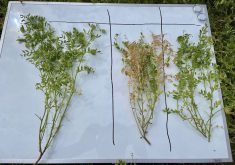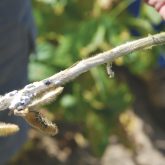We hear a lot about herbicide-resistant weeds these days. Repeated use of herbicides, especially ones from the same group and with similar modes of action, promotes the growth of weed populations that the chemicals can no longer control. A prime example is the emergence of weeds resistant to glyphosate, the most widely used weed control product in the world. Some see it as a canary in the coal mine and a sign of more resistant weeds to come.
But there is another class of pesticides flying below the radar for which resistance is also becoming a problem. These are fungicides used to control fungal diseases in plants. The impact of such diseases cannot be overstated. According to the American Phytopathological Society (APS), fungi are the No. 1 cause of crop loss worldwide. Because plant diseases have a significant impact on yield and quality, managing them becomes an essential part of crop production.
Read Also

Agronomists share tips for evaluating new crop products and tech: Pt. 3
With new products, new production practices and new technology converging on the agriculture industry at a frenetic pace in recent…
Unlike herbicides, which kill established weeds, fungicides are often applied before plant diseases occur, or at least as soon as the first symptoms appear. The APS points out that fungicides can only protect new uninfected growth from disease. Few fungicides are effective against pathogens after they have infected a plant.
But fungicides have one thing in common with herbicides. Their intensive use has produced problems in controlling the pests they are aimed at. An early example was benomyl (marketed as Benlate), a systemic fungicide introduced in the late 1960s by DuPont. The company was forced to cease its production in 2001 because parasitic fungi eventually became resistant to it worldwide, making benomyl largely ineffective.
Fungicide resistance has been known for years in Europe, where fungal diseases can cause significant economic damage to crops. But what about Western Canada, where widespread use of fungicides only became common fairly recently? Is fungicide resistance a problem here as well?
The short answer appears to be no — at least, not yet.
“My personal view, and some of the things I have heard from others, would be that it is not a major issue in Western Canada as it would be, for example, in Europe and other places,” said Dilantha Fernando, a University of Manitoba plant pathologist.
But he adds this warning: “Even though the problem is not an issue at this point, it could become a problem if we don’t manage it correctly.”
How should producers manage fungicides correctly? According to the Fungicide Resistance Action Committee (FRAC), a technical sub-group of CropLife International, the strategies are the same as for herbicides: avoid repetitive and sole use; mix or alternate with other appropriate fungicides; limit the number and timing of treatments; stay within recommended dose rates; and integrate with non-chemical methods.
One of the reasons Europe has problems with fungicide resistance and Western Canada generally doesn’t is simply that Europeans have been using fungicides longer than we have, says Vikram Bisht, a farm production extension pathologist with Manitoba Agriculture, Food and Rural Development. Another reason is that growing conditions in Europe are different. Higher humidity, more intensive production and a lot of small-area crops all contribute to a greater rate of fungicide use.
Another advantage for Western Canada is that canola, its second-biggest crop, has a fair amount of genetic resistance to the two major fungal diseases affecting it: sclerotinia and blackleg. However, that may be starting to change. Fernando says some canola hybrids began to lose resistance to blackleg about five years ago and growers are now starting to consider more fungicide use.
The other major fungal disease in Western Canada is late blight in potatoes. Here, fungicide resistance becomes more of a potential problem. Bisht says the phytophthora fungus of late blight produces a lot of spores, requiring repeated fungicide applications. Sometimes, producers apply half a dozen or more passes during the growing season. If the same fungicide is used, some spores survive the applications and resistant biotypes will multiply. Unfortunately, fungicides are the only answer for fighting late blight so far because the potato varieties which are commercially available have limited genetic resistance to the disease.
“By the end of the season, after five or six applications of that particular chemistry without the use of some other chemistry, resistant types will become a dominant population,” says Bisht. “This is where it is extremely important to either have a tank mix with different groups of fungicides or to rotate them.”
The APS notes the chemistry of fungicides has changed significantly over the years. Early fungicides were multi-site, affecting a number of different metabolic pathways. Although effective, these broad-spectrum fungicides killed all fungi in its path, including ones that were beneficial. Some products were also persistent, remaining in the soil and increasing the pesticide load in the environment. (That was the problem with the insecticide DDT.) Recent fungicides are single-site and active against only one enzyme or protein which the fungus needs. Because they are specific in their toxicity and have little effect on other organisms, single-site products can be absorbed more safely into the plant.
Bisht says there were reasons for switching to single-site fungicides. With single-site, you are selectively controlling the pathogen and not affecting non-target organisms. Also, because of increased stringency in regulatory tests required to register a new active ingredient, fungicide manufacturers found it easier to develop single-site products.
But single-site fungicides come with their own problems. Because these products are specific, fungi are more likely to become resistant to them because a single mutation in the pathogen enables it to overcome the action of the fungicide.
Fernando likens it to being hit repeatedly with a stick. If you’re being hit on the head all the time, you can prepare for the next blow. But if you’re being struck on different parts of the body, you’re not prepared because you don’t know where the next blow will land. The same goes for fungicides. If the fungus repeatedly receives the same fungicide with the same mode of action in the same place, it has an opportunity to mutate so the fungicide isn’t effective any more.
It’s all the more reason to rotate fungicides from different groups and with different modes of action, just as with herbicides, says Bisht.
“Whether you have a fungus or a weed, it is still a pest,” Bisht says. “And if you’re trying to control it with one product, the selection pressure in that pest makes it develop insensitivity. So when you use it again and again, the insensitive ones tend to increase over the sensitive ones.”
Fernando also suggests non-chemical management strategies that do not involve fungicides. For example, a three-year crop rotation can substantially reduce the risk of sclerotinia because other beneficial microbial organisms will consume the sclerotia in the soil.
“You will not eliminate everything, but the numbers will be low enough for farmers to go back to a crop that could be infected by sclerotinia,” Fernando says.
Fernando says burying pathogens in the soil through tillage can make sclerotia decompose fairly quickly. Turning over the soil helps ensure inoculum does not survive on exposed stubble, ready to infect the next crop. But Fernando acknowledges a quick tillage pass to bury infected stubble may not be practical if a producer is practising minimum or zero till.
For that reason, an integrated approach to pest management in which fungicides are not the only means of control is the best strategy in the never-ending fight against plant diseases, Fernando says. “I wouldn’t even start with fungicides because we have a lot of other management strategies that are really useful, user-friendly and environmentally friendly. Farmers can also save some bucks by doing those first.”















